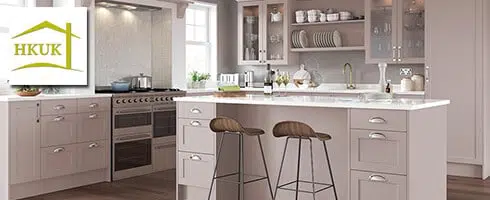This is a manufacturer guide of what to do and avoid when installing your new replacement kitchen doors:
Ensure that the relevant rooms have been left to environmentally stabilise prior to the installation of the doors. Doors must not be installed into a damp moisture rich environment as it will cause undesirable movement in the joints and panels of the doors. You should ensure that you adequately assess conditions.
To minimise any potential damage during installation we make the following recommendations
- Prior to installation confirm that you have the correct quantity and size of the doors.
- Please make sure that you fully inspect the doors before drilling or attaching any hinges or other accessories.
- Take care when unpacking the doors, for example do not use sharp blades to cut away the packaging.
- When drilling or attaching the hinges, place the doors face down on a soft clean surface, ensuring that there is no grit or dust underneath that may cause damage to the surface of the doors. It is good practice to place a clean barrier between the doors and the surface when drilling or attaching the hinges.
- We would recommend that you use a rubber mallet to knock the hinges into the doors without using excessive force.
- Once the hinges have been attached we would recommend that you hang the door immediately to avoid any damage. Do not stack the doors with the hinges touching other doors as this may mark the doors.
- The doors should be stored flat and away from the working area. Please take care when stacking any doors with hinges so that they do not mark the other products.
- Do not lean the doors against each other or against any surface without proper protection in between the same.
- Do not stack the doors on any hard surface as this may cause chipping and scratching along its edge. Prior to fitting, the doors should be stored flat, ensuring that they are not resting on any dirt or debris.
- Please take extreme care not to put the door down with excessive force on any edge, especially the handle edge as this will cause crushing/impact damage on these edges.
Take extreme care not to put the door down on any hard or rough surface such as bare concrete floors, or on any debris such as sawdust, grit or screws, as this can damage the doors. - Where cutting décor panels and trim you must use a sharp quality saw blade of the appropriate grade for fine cutting, or a suitable router. Small chips can appear along the cutedge, and so extra care must be taken to minimise the risk of chipping. Using a blunt or inappropriate saw blade will produce a poor finish and this will not be covered by the manufacturer Warranty
- On Painted Products any fine chips along the cut edge should be smoothed with a fine grade sand paper prior to installation.
- All trims are supplied in long lengths and need to be cut down on site. Please ensure you use the appropriate tools.
- When fitting the plinth, ensure that you check the dimensions of any adjacent appliances. On occasion, the plinth may need to be pulled forward to ensure that it clears the front of the appliance. This can be achieved by fitting blocks using of cuts to the rear of the plinth prior to attaching the plinth clips, to step the plinth forward from its normal position.


